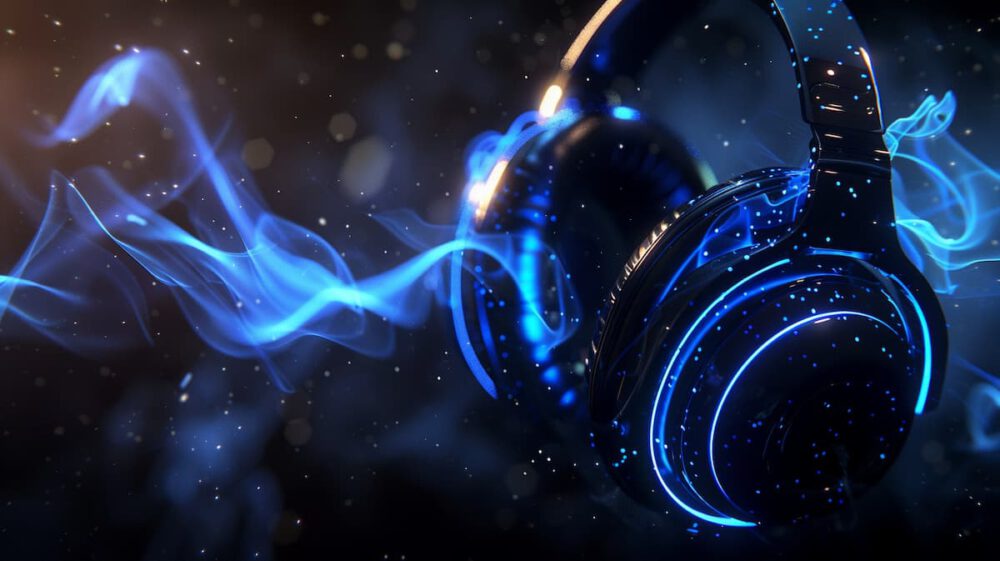
Understanding Blauert’s Bands: Their Significance and Use in Acoustics
Content
Blauert bands are specific frequency ranges that are crucial for the human ability to determine the direction of sounds. These frequency ranges help our brain to precisely localise sound sources.
In this article, you will learn what Blauert bands are and how they are used in acoustics and other fields.
The most important facts at a glance
-
Blauert bands are crucial for sound localisation and the perception of sound directions, which enables directional hearing.
-
The frequency ranges identified by Jens Blauert influence the human auditory system’s ability to locate sounds spatially and are particularly important for acoustic communication.
Applying Blauert bands in audio engineering and virtual reality improves sound reproduction and enables immersive sound experiences.
Blauert bands: their significance and application in acoustics

Blauert bands are crucial for sound localisation and the perception of sound directions. These frequency ranges define the way in which the human ear identifies and localises sound sources.
Blauert bands enable directional hearing, which allows us to precisely determine the origin of sounds.
In addition, computational auditory scene analysis models are used to simulate how auditory information is processed to localize sounds and discern multiple auditory sources in complex environments.
In acoustics, Blauert bands play a crucial role as they define the frequency ranges necessary for localising sound sources. Our ears use interaural phase and sound pressure level differences to locate sound sources.
The outer ear and ear canal also contribute to acoustic filtering and directional perception by amplifying or attenuating certain frequencies.
These findings are applied in sound engineering, music production and many other areas where precise sound localisation is important.
Directional bands basics
Blue-prong bands are special acoustic frequency ranges that are of great importance for human directional hearing. These frequency ranges significantly influence how we perceive sounds and in which directions they can be localised.
Without these frequency ranges, our ability to determine the origin of sounds would be severely limited.
The importance of these frequency ranges goes beyond mere directional hearing. They are crucial for the way we perceive our environment acoustically and react to it.
In the context of the psychophysics of human sound, these frequency ranges play a central role because they analyse the mechanisms and perceptions of human hearing in order to explain differences in localisation and directional hearing.
Whether in our daily lives or in specialised applications such as sound engineering, understanding these frequency ranges helps us to better interpret and process sounds.
Blauert bands and their fundamentals

Blauert bands are frequency ranges that are crucial for the human ear’s directional perception of sound. These bands allow us to detect and distinguish the direction of sound sources, which is fundamental to our survival and communication.
Blauert bands define the frequency ranges that the human ear needs to localise sound sources. Below, we will dive deeper into Jens Blauert’s discovery of these bands and explore the specific frequency ranges and their significance.
The discovery by Jens Blauert
Jens Blauert, a pioneer in the field of acoustics, identified specific frequency bands that facilitate directional hearing in humans. This discovery was groundbreaking because it revolutionised our understanding of how we perceive and localise sound sources in our environment.
Blauert documented the characteristics of these frequency bands and showed how they influence human acoustic perception.
Blauert recognised that certain frequency ranges play an essential role in the perception of sound direction.
His work, published by The MIT Press Cambridge, showed how these frequency bands influence spatial perception of sound and how they are crucial for human directional hearing.
Frequency ranges and their significance for the sound level
The frequency ranges identified by Jens Blauert directly influence human sound localization, particularly in the spatial localization of sounds, which is an important aspect of human sound localisation.
Frequencies above 1600 Hz use interaural level differences for localisation, whereas frequencies below 800 Hz use interaural time differences. This distinction is crucial for precise localisation of sound sources.
Particularly relevant are frequencies around 1 kHz, which exhibit a high recognition rate of over 80% for the ‘back’ direction. These frequencies are especially reliable for identifying sound sources located behind the listener and play a central role in acoustic perception.
Human Auditory System and Sound Waves
The human auditory system is a marvel of biological engineering, enabling us to perceive and interpret sound waves from our environment. Sound waves, which are pressure waves traveling through the air, are detected by the human ear and converted into electrical signals that the brain can understand. The auditory system is composed of three main parts: the outer ear, middle ear, and inner ear. Each part plays a crucial role in the process of hearing.
The outer ear, consisting of the pinna and ear canal, captures sound waves and funnels them towards the eardrum. The middle ear, containing the ossicles (tiny bones), amplifies these sound waves and transmits them to the inner ear. The inner ear, specifically the cochlea, converts these mechanical vibrations into electrical signals that are sent to the brain via the auditory nerve. This intricate process allows us to detect a wide range of sounds and localize sound sources in our environment.
Interaction with Blauert bands
Blauert bands are a fascinating aspect of the human auditory system, playing a pivotal role in our ability to localize sound sources in the horizontal plane. Named after the German acoustician Jens Blauert, these bands are characterized by specific frequency ranges that create a series of peaks and valleys in the sound wave’s frequency spectrum. This interaction between sound waves and the human head generates unique auditory cues that the brain uses to determine the direction of a sound source.
When sound waves encounter the head, they are diffracted and reflected, creating complex patterns of sound pressure levels and phase differences. These patterns, known as Blauert bands, are essential for accurate sound localization. The human auditory system analyzes these peaks and valleys to pinpoint the location of a sound source, allowing us to navigate our environment with precision.
Localisation of sound in the median plane

Localising sound in the median plane is particularly challenging. The Blauert’s bands are crucial for directional hearing in this plane and help to localise the origin of sound sources. These frequency ranges influence the perception of sound directions such as front, back and above.
Vestibular and visual cues also play a significant role in enhancing the accuracy of auditory perception, particularly in challenging acoustic environments.
An increase in the sound level in these frequency ranges can support the perception of a sound source from the front above, behind. Therefore, the Blauert bands are particularly important for the acoustic perception of reflections that influence the location of sound.
Acoustic resonator system and head related transfer function of the outer ear
The outer ear and the ear canal form an acoustic resonator system that depends on the direction of the sound incidence. These anatomical structures, including the pinna, contribute to the head related transfer function, which helps the brain to precisely locate the origin of the sound.
Jens Blauert described the frequency ranges he discovered as direction-determining bands, which are important for human directional hearing in the median plane. These bands enable the human brain to precisely localise sound sources, which is of great importance for acoustic communication.
Localisation precision
The accuracy of sound localization in the median plane is influenced by factors such as interaural time difference (ITD) and interaural level difference (ILD), resulting in higher uncertainty compared to the horizontal plane. Compared to the horizontal plane, sound localization in the median plane shows greater errors in determining direction.
Factors such as the position of the sound event and head movements can influence the accuracy of localization in the median plane. These factors mean that the precision of sound localization in the median plane is limited, resulting in a sharpness of approximately 10°.
Auditory Cues for Sound Source Localization
Auditory cues are the various types of information that the human auditory system uses to localize sound sources in our environment. These cues are essential for spatial hearing and enable us to determine the direction and distance of sounds. There are several types of auditory cues, each providing unique information that helps the brain to localize sound sources accurately.
Role of Blauert bands in auditory cues
Blauert bands are integral to the auditory cues used for sound source localization. These frequency ranges are particularly effective for localizing sound sources in the horizontal plane, especially within the frequency range of 500-2000 Hz. Blauert bands work in conjunction with other auditory cues to enhance localization accuracy.
In addition to Blauert bands, the human auditory system relies on several other auditory cues:
-
Interaural time differences (ITDs): These are the differences in the time it takes for a sound wave to reach each ear. ITDs are crucial for determining the location of a sound source in the horizontal plane, especially for low-frequency sounds.
-
Interaural level differences (ILDs): These are the differences in the sound pressure level that reaches each ear. ILDs are used to localize high-frequency sounds and are particularly useful for determining the vertical position of a sound source.
-
Head-related transfer functions (HRTFs): These describe the changes in a sound wave’s frequency spectrum as it interacts with the human head, pinna, and torso. HRTFs provide detailed information about the location of a sound source in three-dimensional space.
By combining these auditory cues, including Blauert bands, ITDs, ILDs, and HRTFs, the human auditory system can accurately localize sound sources in our environment. This complex interplay of cues allows us to navigate and interact with our surroundings effectively, enhancing our spatial hearing capabilities.
Localisation and distance
Influence of Blauert bands on distance estimation
The Blauert bands play a crucial role in the localisation of sound sources in the median plane. These special frequency ranges enable the human ear to precisely determine not only the direction but also the distance of a sound source.
Estimating distance is a complex phenomenon that depends on various factors such as the sound source, direction and distance. The Blauert’s bands contribute significantly to this by changing the intensity and spectral characteristics of the sound signal.
When the sound level is increased in a particular frequency range, the ear can extract information about whether the sound is coming from the front, top or back. These directional bands are therefore of great importance for estimating distance.
An example of the practical application of these findings is adjusting the sound level in specific frequency ranges to influence the perception of distance.
Increasing the sound level in a certain frequency range can change the perceived intensity of the sound signal, which in turn influences the distance estimation.
This is particularly relevant in sound engineering and in the design of acoustic environments where precise distance estimation is crucial.
Overall, the Blauert bands contribute significantly to the human auditory system’s ability to localise sound sources in the median plane and to estimate their distance.
These findings are not only important for basic research in acoustics, but also have practical applications in various fields such as audio technology and virtual reality.
Electronic simulation of sound discolouration

The electronic simulation of sound colouration has revolutionised the way we perceive sound. By applying Blauert bands in sound processing, the auditory impression can be created that sound is coming from different directions.
Interestingly, the same sound can elicit different reactions based on context, highlighting the brain’s role in interpreting auditory information.
This technology is widely used to improve the localisation of sound sources and to create a realistic spatial perception.
Blauert bands are particularly useful in acoustics as they help to improve sound reproduction in various media. In the following subsections, we will take a closer look at specific applications in sound engineering and music production, as well as their influence on hi-fi sound and loudspeaker stereophony.
Applications in sound engineering and music production
In audio engineering, the simulation of sound colouration enables more precise sound editing and adjustment during recording and mixing. By boosting frequencies in specific areas, such as around 1 kHz, the perception of sound direction can be influenced. These boosts can be simulated by acoustic filters.
Sound colouration is often used to support the creation of spatial sound in music productions. This enables producers to create realistic and immersive sound experiences that immerse the listener in the music.
Influence on hi-fi sound and loudspeaker stereophony
The correct simulation of sound colouration helps to improve stereophony in speaker systems. By applying Blauert’s bands, hi-fi systems can achieve more realistic and precise sound reproduction, significantly enhancing the listening experience.
This is especially important for audiophiles and music lovers who expect the highest sound quality. The precise localisation of sound sources and the improved spatial perception help to ensure that music is experienced as the artist intended.
Practical Applications of Blauert’s Bands

The use of digital signal processing has significantly expanded the possibilities for sound generation and processing. These technologies allow sound colouration to be precisely edited, which increases the quality in music production and other applications.
The electronic simulation of sound colouration is crucial for creating realistic sound experiences in various fields. In the following, we will take a closer look at two specific applications: dummy head stereophony and spatial hearing in virtual reality.
Dummy head stereophony
The first dummy head was developed in the 1930s to create binaural sounds for audio recording. This technology uses special microphones to record sound waves in a way that mimics the natural hearing conditions of the human ear.
Dummy head stereophony uses microphones in the dummy head to recreate the natural sound effects when listening. These recordings contain discolouration and localisation information that enables a realistic and immersive sound experience.
Spatial Hearing in Virtual Reality
In virtual reality, Blauert bands are used to create a realistic sound environment that enhances user immersion. These frequency ranges make it possible to precisely localise sound sources, creating an immersive sound experience that improves users’ spatial perception.
Applying Blauert’s bands in virtual environments can enable realistic sound source localisation. This helps to ensure that users experience an authentic and intense sound experience that makes virtual reality even more immersive.
Future and development
New technologies and research trends
Research into the Blauert bands and their role in localising sound sources in the median plane is a dynamic field that is constantly producing new developments and technologies. These advances open up exciting possibilities for the application and further development of acoustics.
One of the most significant developments in this area is the introduction of new algorithms and methods for analysing and modelling sound signals.
These algorithms enable a more precise analysis of the characteristics of sound signals and thus improve the ability to localise sound sources in the median plane. By applying these advanced techniques, acoustic systems can be optimised and sound reproduction improved.
Another important trend is the integration of artificial intelligence (AI) into research on Blauert bands. AI algorithms can be used to analyse and model the properties of sound signals, further improving the localisation of sound sources in the median plane.
These technologies are already being applied in audio technology and offer promising prospects for the future.
In addition, current research trends are focusing on the application of Blauert bands in various fields such as music, audio technology and medicine. In music production, these findings enable more realistic and immersive sound design.
In medicine, they could contribute to the development of new diagnostic and treatment methods based on the precise analysis of sound signals.
Overall, research on the Blauert bands and their role in localising sound sources in the median plane is a dynamic and forward-looking field.
The continuous advances in this area will undoubtedly help to deepen our understanding of acoustic perception and develop new applications and technologies that further enhance our listening experience.
Summary
Blauert bands play a crucial role in acoustics and sound localisation. From their discovery by Jens Blauert to the specific frequency ranges that enable directional hearing, they have revolutionised our understanding of sound perception.
Applications in sound engineering, hi-fi systems and virtual reality show how versatile and important these frequency ranges are.
In summary, Blauert bands allow us to precisely localise sound sources and create an immersive sound experience. Their importance in acoustics and sound engineering cannot be overstated, and their applications will continue to shape the way we perceive and experience sound.
Back to the BlogFrequently asked questions
What are Blauert bands?
Blauert bands are specific frequency ranges that are crucial for human directional hearing. They play an important role in spatial hearing and sound localisation.
Who discovered Blauert bands?
Blauert bands were discovered by Jens Blauert, a leading pioneer in the field of acoustics.
How do Blauert bands influence sound localisation?
Blauert bands influence sound localisation by defining certain frequency ranges that the human ear uses to perceive and localise sound sources. These bands are crucial for the acoustic identification of sounds in space.
What role do Blauert bands play in sound engineering?
Blauert bands play a crucial role in sound engineering because they enable more precise sound processing and the creation of spatial sound.
How are Blauert bands used in virtual reality?
Blauert bands are used to create a realistic sound environment in virtual reality, which significantly improves spatial perception and user immersion.